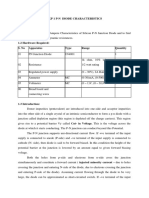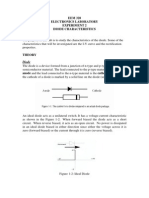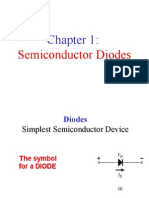Experiment: 01 Characteristics of PN Junction Diode Aim
Experiment: 01 Characteristics of PN Junction Diode Aim
Uploaded by
aty27062004Copyright:
Available Formats
Experiment: 01 Characteristics of PN Junction Diode Aim
Experiment: 01 Characteristics of PN Junction Diode Aim
Uploaded by
aty27062004Original Description:
Original Title
Copyright
Available Formats
Share this document
Did you find this document useful?
Is this content inappropriate?
Copyright:
Available Formats
Experiment: 01 Characteristics of PN Junction Diode Aim
Experiment: 01 Characteristics of PN Junction Diode Aim
Uploaded by
aty27062004Copyright:
Available Formats
.
EXPERIMENT: 01
CHARACTERISTICS OF PN JUNCTION DIODE
Aim:
1. To plot the forward characteristics of a silicon PN junction
2. To find the dynamic resistance of the diode
Components and equipments required:
Diode,resistors,multimeters
Theory:
The diode consists of p- and n-type material fabricated to form a junction. The junction between n and p
materials is the basis for the name junction diode. A p-n junction is formed either with Germanium or
Silicon crystal. The p and n type regions are referred to as anode and cathode respectively .A p-n junction
diode is a one way device (i.e. conduct under forward-biased condition only) offering low resistance
when forward biased and behaves as an insulator (very high or infinite resistance) when reverse biased.
Forward characteristics:
The diode is forward biased and the applied voltage is increased from zero. Hardly any current
flows through the device till the barrier voltage (or cut-in voltage )(0.2V for Ge and 0.7V for Si)is
reached.Once the diode is turned on, the forward current is noted for different values of forward voltage
in steps of 0.2V.The forward characteristics is drawn by plotting a graph between voltage (X-axis) and
current(Y-axis).
At a given operating point the static resistance (R d) and the dynamic resistance (rd) are found from
its characteristics .The static resistance (also called dc resistance) is defined as the ratio of the voltage to
current at the operating point.
Rd=V/I ohms
Thus the dc resistance is obtained by direct application of ohm’s law. The dynamic resistance (also called
ac resistance) is a ratio of small change in voltage, ΔV to small change in current ΔI) is given by
rd= ΔV/ ΔI ohms
Circuit Diagram:
Basic Electronics Lab Page 1
Observation: Model Graph
Sl. Voltage(V) Current(mA)
No
Calculation:
1. Dynamic resistance rd= ΔV/ ΔI=………… ohms
2. Cut in voltage,Vc=…………Volts
Basic Electronics Lab Page 2
Result:
EXPERIMENT: 02
CHARACTERISTICS OF ZENER DIODE
Aim:
1. To plot the reverse characteristics of a Zener diode
2. To calculate dynamic resistance of a Zener diode reverse conditions.
Components and equipments required:
ZenerDiode,resistors,multimeters
Theory:
Zener or breakdown diodes are semi-conductor p-n junction diodes with controlled reverse bias
properties which make them extremely useful in many applications especially as voltage-regulating
devices. The reverse characteristics exhibits a region in which the reverse voltage (Zener voltage V z) is
almost independent of the Zener diode current I z. The Zener voltage of any particular diode is controlled
by the amount of doping applied during the manufacturing process. Typical values range from 2V to
200V, with power handling capabilities of 100W.When this circuit is properly designed, the load voltage
VL remains at an essentially constant value, even though the input voltage and the load resistance vary
over wide ranges. But if the reverse bias is increased, at a particular voltage the diode starts conducting
heavily. This voltage is called breakdown voltage. When breakdown occur the high current in the circuit
is limited by a resistance in series with the Zener diode. Once the diode starts conducting it maintains a
constant voltage across its terminals whatever be the current through it. Hence it has a very low dynamic
resistance. Zener diodes with Zener voltages of 5.6V, 6.2V, 6.8V, 7.5V, 9.1V etc are available.
Circuit Diagram:
Basic Electronics Lab Page 3
Observation: Model Graph:
Sl.No Voltage(V) Current(mA)
Calculation:
1. Dynamic resistance rd= ΔV/ ΔI=………… ohms
2. Breakdown voltage, Vz=…………Volts
Result:
Basic Electronics Lab Page 4
You might also like
- Shigley's Mechanical Engineering Design 9th Edition Solutions ManualDocument6 pagesShigley's Mechanical Engineering Design 9th Edition Solutions ManualDarren Hentschel27% (26)
- En 1074 - 2 - 20181030 - 0001Document16 pagesEn 1074 - 2 - 20181030 - 0001Rishab KejriwalNo ratings yet
- Lab 11 - DiodesDocument7 pagesLab 11 - DiodesJuliánDavidMesaCárdenasNo ratings yet
- EDCDocument232 pagesEDClakshmipo67% (3)
- A Guide to Electronic Maintenance and RepairsFrom EverandA Guide to Electronic Maintenance and RepairsRating: 4.5 out of 5 stars4.5/5 (7)
- Basic Electronics Lab Exp 2 & 3Document11 pagesBasic Electronics Lab Exp 2 & 3Priyam DasNo ratings yet
- Zener Diode CharaDocument12 pagesZener Diode Charaaleena s lNo ratings yet
- Lab Manual Basic Electrical & Electronics Engineering-B.tech-Eee-2ndDocument31 pagesLab Manual Basic Electrical & Electronics Engineering-B.tech-Eee-2ndDeepanshu GuptaNo ratings yet
- Basic Electronics LabDocument60 pagesBasic Electronics Labrahulsingle67% (3)
- Electron DeviceDocument112 pagesElectron DevicekrishnaNo ratings yet
- Study of Diode CharacteristicsDocument6 pagesStudy of Diode CharacteristicsBhavyaNo ratings yet
- Experiment 1Document8 pagesExperiment 1Qusai BakerNo ratings yet
- Lab ManualDocument8 pagesLab Manualbond 777No ratings yet
- PN Junction LabManual PDFDocument69 pagesPN Junction LabManual PDFRaja bhaskarNo ratings yet
- 1-Diode Characteristics and Rectifier CircuitsDocument17 pages1-Diode Characteristics and Rectifier CircuitsAnjan SenguptaNo ratings yet
- Exp 02Document7 pagesExp 02M. Ahmad RazaNo ratings yet
- I-V Characteristics of Diode-Final-RUBEL MIA-5096190105Document12 pagesI-V Characteristics of Diode-Final-RUBEL MIA-5096190105Md Rubel hosainNo ratings yet
- EEM328 Electronics Laboratory - Experiment 2 - Diode CharacteristicsDocument4 pagesEEM328 Electronics Laboratory - Experiment 2 - Diode Characteristicsdonatello84100% (3)
- Physics Lab Manual Final1 03.11.08 PDFDocument50 pagesPhysics Lab Manual Final1 03.11.08 PDFWWE SuperstarsNo ratings yet
- Ec8261 CD Lab ManualDocument92 pagesEc8261 CD Lab ManualthasleemaNo ratings yet
- Experiment 1 Eng NaderDocument8 pagesExperiment 1 Eng Naderياسر العويطيNo ratings yet
- Experiment-No 2Document5 pagesExperiment-No 2carloNo ratings yet
- EEE206 Device Lab ManualDocument117 pagesEEE206 Device Lab ManualGiaa RahmanNo ratings yet
- ECE2200 Lct1 DiodeDocument4 pagesECE2200 Lct1 Diodedmanzo753No ratings yet
- Experiment 7 Study of V - I Characteristics of Zener Diode and Determine Its Voltage Regulation.Document7 pagesExperiment 7 Study of V - I Characteristics of Zener Diode and Determine Its Voltage Regulation.Tushar SharmaNo ratings yet
- Eee 111 Lab Manual 2-8 (Latest)Document32 pagesEee 111 Lab Manual 2-8 (Latest)Ismot Jahan MoniNo ratings yet
- PN Junction Diode-2Document45 pagesPN Junction Diode-2RAUNAK GARGNo ratings yet
- Edc - 2 Marks With AnswerDocument0 pagesEdc - 2 Marks With AnswerJoshua DuffyNo ratings yet
- D IODESDocument62 pagesD IODESCllyan Reyes0% (1)
- (L4) - (JLD 3.0) - Semiconductors - 30th DecDocument66 pages(L4) - (JLD 3.0) - Semiconductors - 30th DecAshfaq khanNo ratings yet
- Semiconductor DiodeDocument74 pagesSemiconductor DiodeOnie EstrellaNo ratings yet
- Lab 01 P-N DiodeDocument5 pagesLab 01 P-N DiodeyayayehNo ratings yet
- Lab reportTTDocument13 pagesLab reportTTPaa Kwesi ArhinfulNo ratings yet
- Lab1 Diode Characteristics1588856822Document2 pagesLab1 Diode Characteristics1588856822badalabhinav10No ratings yet
- Analog Electronics I: DiodesDocument31 pagesAnalog Electronics I: DiodesRachul heenimNo ratings yet
- ECE 202 - Exp 1Document4 pagesECE 202 - Exp 1Nusrat FatemaNo ratings yet
- Ec0221 Ed Lab ManualDocument68 pagesEc0221 Ed Lab ManualGoutham ShanNo ratings yet
- Lecture 4Document31 pagesLecture 4Pratham AgarwalNo ratings yet
- JJJJJDocument148 pagesJJJJJTanXiNingNo ratings yet
- Industrial ElectronicsDocument28 pagesIndustrial ElectronicsAttaUrRahmanNo ratings yet
- Chapter1 (Semiconductor Diodes) ReviseDocument30 pagesChapter1 (Semiconductor Diodes) Revisejohn456royNo ratings yet
- Experiment 1Document17 pagesExperiment 1Eng.Mohammed ReyadNo ratings yet
- Edc Lab ManualDocument35 pagesEdc Lab ManualYAMINI D SDECT013No ratings yet
- Notes On Diodes and Applications 4Document60 pagesNotes On Diodes and Applications 4Abhinav DhimanNo ratings yet
- Electronic Device Lab 1 Diode CharacteristicsDocument9 pagesElectronic Device Lab 1 Diode CharacteristicsVy NguyễnNo ratings yet
- Electric Power Generation2Document28 pagesElectric Power Generation2Majdi M. AbabnehNo ratings yet
- Experiment No: 0D6: Apparatus RequiredDocument7 pagesExperiment No: 0D6: Apparatus RequiredPreeti PundirNo ratings yet
- Eee - Exp 6-10Document22 pagesEee - Exp 6-10Niurka ChicoNo ratings yet
- Prepared By: Name:Trushali Mistry Enroll. No.: 130940111049 Branch: E.C. Sem.: 3Document20 pagesPrepared By: Name:Trushali Mistry Enroll. No.: 130940111049 Branch: E.C. Sem.: 3RAJKUMARNo ratings yet
- P-N Junction Diode CharacteristicsnewDocument5 pagesP-N Junction Diode CharacteristicsnewHarish GANANATHAN SBNo ratings yet
- Edc Lab Exp 1aand1bDocument10 pagesEdc Lab Exp 1aand1bJames TonyNo ratings yet
- Lecture 5Document19 pagesLecture 5Pratham AgarwalNo ratings yet
- Exp 45Document11 pagesExp 45tanmay sonawaneNo ratings yet
- Diode Test and FamiliarizationDocument4 pagesDiode Test and Familiarizationcent carinoNo ratings yet
- Week 2 - ELEC311 CH 2 Ch1 of Course PackDocument29 pagesWeek 2 - ELEC311 CH 2 Ch1 of Course PackDavid Mitry ThomasNo ratings yet
- Experiment 6 Diode CharacteisticsDocument4 pagesExperiment 6 Diode CharacteisticsAbral QureshiNo ratings yet
- DiodeDocument20 pagesDiodehabtemariam mollaNo ratings yet
- PE1 - Lect 2-Diode LoadsDocument19 pagesPE1 - Lect 2-Diode LoadsAbdel-aziz SamiNo ratings yet
- Laboratory Report Cover Sheet: 21Ecc211L - Devices and Digital Ic Lab Third Semester, 2023-24 (Odd Semester)Document12 pagesLaboratory Report Cover Sheet: 21Ecc211L - Devices and Digital Ic Lab Third Semester, 2023-24 (Odd Semester)nikunj sharmaNo ratings yet
- Easy(er) Electrical Principles for General Class Ham License (2019-2023)From EverandEasy(er) Electrical Principles for General Class Ham License (2019-2023)No ratings yet
- AviationDocument49 pagesAviationaty27062004No ratings yet
- Basic Electronics Engineering:: AV 121 Semester-IIDocument24 pagesBasic Electronics Engineering:: AV 121 Semester-IIaty27062004No ratings yet
- Root LocusDocument26 pagesRoot Locusaty27062004No ratings yet
- Basic Electronics Engineering:: AV 121 Semester-IIDocument23 pagesBasic Electronics Engineering:: AV 121 Semester-IIaty27062004No ratings yet
- Topic2 - Force Method of Analysis TrussDocument24 pagesTopic2 - Force Method of Analysis TrussMary Joanne Capacio AniñonNo ratings yet
- Laser AttenuationDocument8 pagesLaser AttenuationMARTIN TIRKEYNo ratings yet
- BiophysicsDocument763 pagesBiophysicsBibo BobiNo ratings yet
- Mathematics PDFDocument27 pagesMathematics PDFarvind lakshmi ranjanNo ratings yet
- Cecilia Garraffo Juli An D. Alvarado-G Omez Ofer Cohen Jeremy J. DrakeDocument9 pagesCecilia Garraffo Juli An D. Alvarado-G Omez Ofer Cohen Jeremy J. DrakeGheorghe SavaNo ratings yet
- PHYS 101 Midterm Exam 1 Solution 2021-22-2Document3 pagesPHYS 101 Midterm Exam 1 Solution 2021-22-2Tuğba AydemirNo ratings yet
- NdFeB TableDocument2 pagesNdFeB TablemmrNo ratings yet
- Thin-Walled Structures: L.C.M. Vieira JR., M. Malite, B.W. SchaferDocument9 pagesThin-Walled Structures: L.C.M. Vieira JR., M. Malite, B.W. SchaferJan LerryNo ratings yet
- Doktek-45 Astm D5617Document5 pagesDoktek-45 Astm D5617Dimas NugrahaNo ratings yet
- Piso in Icofoam: Håkan Nilsson 1Document15 pagesPiso in Icofoam: Håkan Nilsson 1Xingxing HuangNo ratings yet
- Nsep PDFDocument5 pagesNsep PDFAnusha D RejaNo ratings yet
- Introduction To Alchemy in Jungian PsychologyDocument24 pagesIntroduction To Alchemy in Jungian Psychologynmjoshi77859100% (2)
- Troubleshooting Guide For Wheel DryersDocument2 pagesTroubleshooting Guide For Wheel DryerskmasanNo ratings yet
- Sag: Sag Is A Vertical Distance From The Horizontal Line Between The Tops of TheDocument6 pagesSag: Sag Is A Vertical Distance From The Horizontal Line Between The Tops of TheMd. Ruhul AminNo ratings yet
- Star Life Cycle Web Activity v2Document6 pagesStar Life Cycle Web Activity v2blackwellbertNo ratings yet
- Wang 2018Document11 pagesWang 2018MauricioGallardoNo ratings yet
- Arc Flash PalawanDocument58 pagesArc Flash PalawanChristopher BalbuenaNo ratings yet
- Class X Physics Chapter 11 - Calorimetry Exercise 11 (A)Document16 pagesClass X Physics Chapter 11 - Calorimetry Exercise 11 (A)Isha PatelNo ratings yet
- Geotechnic-JKR ProbeDocument4 pagesGeotechnic-JKR Probeahmad adliNo ratings yet
- Solution: Construction of The CircleDocument1 pageSolution: Construction of The CircleSpide-O- BubblesNo ratings yet
- English Descriptive Paragraph by PriyanshuDocument4 pagesEnglish Descriptive Paragraph by PriyanshuPriyanshuNo ratings yet
- Afd Ec 9 2007Document52 pagesAfd Ec 9 2007Nguyen Co ThachNo ratings yet
- IS 3803-2-1989 Steel Conversion of Elongation Values - Part-2 Austenitic SteelsDocument35 pagesIS 3803-2-1989 Steel Conversion of Elongation Values - Part-2 Austenitic SteelsAnwarul AfrojNo ratings yet
- Structure and Spectra of Diatomic MoleculesDocument38 pagesStructure and Spectra of Diatomic MoleculesmanuuNo ratings yet
- Ms2N Synchronous Servomotors: Project Planning ManualDocument408 pagesMs2N Synchronous Servomotors: Project Planning ManualGuido PerezNo ratings yet
- Improved Three-Phase Equilibrium Calculation Algorithm For Waterhydrocarbon MixturesDocument11 pagesImproved Three-Phase Equilibrium Calculation Algorithm For Waterhydrocarbon MixturesYTNo ratings yet
- Temperature Sensor NTC M12: Application Mechanical DataDocument2 pagesTemperature Sensor NTC M12: Application Mechanical DataheinzNo ratings yet
- FAARFIELD Design ReportDocument3 pagesFAARFIELD Design ReportRahul RanaNo ratings yet





























































































